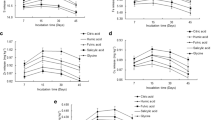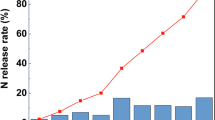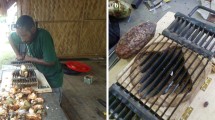Abstract
The losses of nitrogen (N) fertilizer applied to the soil microenvironment reduce its efficiency. Different strategies like the use of polymer coating and chemical nitrification inhibitors had been employed to reduce N losses. But these chemical nitrification inhibitors are very expensive. Thus, a study was conducted to investigate the effects of different concentrations of Parthenium extract, neem oil, and acidulated cow dung compost extract on N dynamics in the soil. Three concentrations of Parthenium extract (5, 10, and 15%) and neem oil (1, 2, and 3%) were coated on urea granules using a polymer as the binding agent. Three pH (2, 4, and 6 pH) based acidulated cow dung compost extracts were also coated on urea granules in the same pattern. These coated fertilizers and uncoated urea were applied in jars filled with soil (100 g per jar) at the rate of 1 g of fertilizer per jar. One treatment was kept as control (without fertilizer). Treatments along three replications were arranged according to the completely randomized design. Results depicted that all coating materials caused the release of N consistently from applied fertilizers compared to uncoated treatment. In addition, percent nitrified N was also reduced significantly in coated treatments in comparison to the uncoated urea and control treatments. However, the level of concentration effect was not obvious as lower concentrations of these extracts and oil also performed almost equal to that of higher concentrations in inhibiting nitrification process.



Similar content being viewed by others
References
Abbas Q, Yousaf B, Ali MU, Munir MAM, El-Naggar A, Rinklebe J, Naushad M (2020) Transformation pathways and fate of engineered nanoparticles (ENPs) in distinct interactive environmental compartments: a review. Environ Int 138:105646. https://doi.org/10.1016/j.envint.2020.105646
Anas M, Liao F, Verma KK, Sarwar MA, Mahmood A, Chen ZL, Li Q, Zeng XP, Liu Y, Li YR (2020) Fate of nitrogen in agriculture and environment: agronomic, eco-physiological and molecular approaches to improve nitrogen use efficiency. Biol Res 53:1–20. https://doi.org/10.1186/s40659-020-00312-4
Beig B, Niazi MBK, Jahan Z, Kakar SJ, Shah GA, Shahid M, Zia M, Haq MU, Rashid MI (2020) Biodegradable polymer coated granular urea slows down N release kinetics and improves spinach productivity. Polymers 12:2623. https://doi.org/10.3390/polym12112623
Belete F, Dechassa N, Molla A, Tana T (2018) Effect of nitrogen fertilizer rates on grain yield and nitrogen uptake and use efficiency of bread wheat (Triticum aestivum L.) varieties on the Vertisols of central highlands of Ethiopia. Agric Food Sec 7:1–12. https://doi.org/10.1186/s40066-018-0231-z
Byrne MP, Tobin JT, Forrestal PJ, Danaher M, Nkwonta CG, Richards K, Cummins E, Hogan SA, O’Callaghan TF (2020) Urease and nitrification inhibitors—as mitigation tools for greenhouse gas emissions in sustainable dairy systems: a review. Sustainability 12:6018. https://doi.org/10.3390/su12156018
Castellano-Hinojosa A, González-López J, Vallejo A, Bedmar EJ (2019) Linking ammonia volatilization with moisture content and abundance of nitrification and denitrification genes in N-fertilized soils. In ‘Microbial Probiotics for Agricultural Systems’. Springer, Cham, pp 29–43. https://doi.org/10.1007/978-3-030-17597-9_3
Chandrasena N, Narayana A (2018) Parthenium weed: uses and Parthenium Weed. Biol Ecol Manag 7:190
Freedman B (2018) ~ Flows and cycles of nutrients. In ‘Environmental Science’. (Dalhousie Libraries)
Fumasoli A, Bürgmann H, Weissbrodt DG, Wells GF, Beck K, Mohn J, Morgenroth E, Udert KM (2017) Growth of Nitrosococcus-related ammonia oxidizing bacteria coincides with extremely low pH values in wastewater with high ammonia content. Environ Sci Technol 51:6857–6866. https://doi.org/10.1021/acs.est.7b00392
Hatano S, Fujita Y, Nagumo Y, Ohtake N, Sueyoshi K, Takahashi Y, Sato T, Tanabata S, Higuchi K, Saito A, Ohyama T (2019) Effect of the nitrification inhibitor 3, 4 dimethylpyrazole phosphate on the deep placement of nitrogen fertilizers for soybean cultivation. Int J Agron 2019:9724214. https://doi.org/10.1155/2019/9724214
Itelima JU, Bang WJ, Onyimba IA, Sila MD, Egbere OJ (2018) Bio-fertilizers as key player in enhancing soil fertility and crop productivity: a review. Direct Res J Agric Food Sci 6:73–83. http://hdl.handle.net/123456789/1999
Jain V, Abrol YP (2017) Plant nitrogen use efficiency. In ‘The Indian Nitrogen Assessment’. Elsevier, pp 163–173. https://doi.org/10.1016/B978-0-12-811836-8.00011-2
Kanchan S, Jayachandra (1981) Effect of Parthenium hysterophorus on nitrogen-fixing and nitrifying bacteria. Can J Bot 59(2):199–202. https://doi.org/10.1139/b81-030
Kaur M, Aggarwal NK, Kumar V, Dhiman R (2014) Effects and Management of Parthenium hysterophorus: a weed of global significance. Int Sch Res Notices 2014:368647. https://doi.org/10.1155/2014/368647
Keeney DR, Nelson DW (1989) Nitrogen inorganic forms. In ‘Methods of soil analysis part 2. Chemical and microbiological properties. Madison (WI): Soil Science Society of America and American Society of Agronomy’. pp 643–698
Kumar D, Devakumar C, Kumar R, Panneerselvam P, Das A, Shivay YS (2011) Relative efficiency of prilled urea coated with major neem (Azadirachta indica A. Juss) oil components in lowland irrigated rice of the Indo-Gangetic plains. Arch Agron Soil Sci 57:61–74. https://doi.org/10.1080/03650340903223144
Lasisi AA, Akinremi OO, Kumaragamage D (2019) Efficacy of a new N-(n-butyl) thiophosphorictriamide formulation in reducing ammonia volatilization from urea-based fertilizers. Can J Soil Sci 99:395–405. https://doi.org/10.1139/cjss-2018-0072
Leghari SJ, Wahocho NA, Laghari GM, HafeezLaghari A, MustafaBhabhan G, HussainTalpur K, Bhutto TA, Wahocho SA, Lashari AA (2016) Role of nitrogen for plant growth and development: a review. Adv Environ Biol 10:209–219
Lei T, Gu Q, Guo X, Ma J, Zhang Y, Sun X (2018) Urease activity and urea hydrolysis rate under coupling effects of moisture content, temperature, and nitrogen application rate. Int J Agric Biol Eng 11:132–138. https://doi.org/10.25165/j.ijabe.20181102.3784
Li HF, An SD, Zhang L, Peng H, Ma W, Meng X, Ye HM (2021) Urea fertilizer with precisely regulable slow-release performance by complexing with random copolyester. J Environ Chem Eng 9:105120. https://doi.org/10.1016/j.jece.2021.105120
Mahmood R, Shahid AA, Usmani A, Haider MS, Ali S (2014) Nitrification inhibition potential of various leaf extracts. Philipp Agric Sci 97:287–293
Netsere A, Mendesil E (2011) Allelopathic effects of Parthenium hysterophorus L. aqueous extracts on soybean (Glycine max L.) and haricot bean (Phaseolus vulgaris L.) seed germination, shoot and root growth and dry matter production. J Appl Bot Food Qual 84:219–222
Noor S, Yaseen M, Naveed M, Ahmad R (2017) Use of controlled release phosphatic fertilizer to improve growth, yield and phosphorus use efficiency of wheat crop. Pak J Agric Sci 54:541–547. https://doi.org/10.21162/PAKJAS/18.6533
Opoku A, Chaves B, De Neve S (2014) Neem seed oil: a potent nitrification inhibitor to control nitrate leaching after incorporation of crop residues. Biol Agric Hortic 30:145–152. https://doi.org/10.1080/01448765.2014.885394
Plaimart J, Acharya K, Mrozik W, Davenport RJ, Vinitnantharat S, Werner D (2021) Coconut husk biochar amendment enhances nutrient retention by suppressing nitrification in agricultural soil following anaerobic digestate application. Environ Pollut 268:115684. https://doi.org/10.1016/j.envpol.2020.115684
Puri HS (1999) Neem-the divine tree. Harwood academic publishers, Amsterdam
Rose TJ, Kearney LJ, Van Zwieten L, Rose MT (2020) Low pH of a high carbon gleysol contributes to nitrification inhibition resulting in low N2O soil emissions and limited effectiveness of nitrification inhibitors. Soil Syst 4:75. https://doi.org/10.3390/soilsystems4040075
Savich V, Novik G (2021) Waste biodegradation and utilization by Pseudomonas species. J Microbiol Biotechnol Food Sci 2021:851–857. https://doi.org/10.15414/jmbfs.2016.6.2.851-857
Shafiq F, Irfan S, Shakir SK (2020) Comparative allelopathic effects of different parts of Parthenium hysterophorus L. on seed germination and biomasses of Cicer arietinum L. J Stress Physiol Biochem 16:64–75
Shivay YS, Pooniya V, Prasad R, Pal M, Bansal R (2016) Sulphur-coated urea as a source of sulphur and an enhanced efficiency of nitrogen fertilizer for spring wheat. Cereal Res Commun 44:513–523. https://doi.org/10.1556/0806.44.2016.002
Sigurdarson JJ, Svane S, Karring H (2018) The molecular processes of urea hydrolysis in relation to ammonia emissions from agriculture. Rev Environ Sci Biotechnol 17(2):241–258. https://doi.org/10.1007/s11157-018-9466-1
Steel RGD, Torrie JH, Dickey DA (1997) Principles and procedures of statistics, 2nd edn. McGraw Hill Inc., New York, USA
Tao H, Morris TF, Kyveryga P, McGuire J (2018) Factors affecting nitrogen availability and variability in cornfields. Agron J 110:1974–1986. https://doi.org/10.2134/agronj2017.11.0631
Tong X, He X, Duan H, Han L, Huang G (2018) Evaluation of controlled release urea on the dynamics of nitrate, ammonium, and its nitrogen release in black soils of northeast China. Int J Environ Res Public Health 15:119. https://doi.org/10.3390/ijerph15010119
Trinh TH, Kushaari K, Shuib AS, Ismail L, Azeem B (2015) Modelling the release of nitrogen from controlled release fertiliser: constant and decay release. Biosyst Eng 130:34–42. https://doi.org/10.1016/j.biosystemseng.2014.12.004
Van Eerd LL, Turnbull JJD, Bakker CJ, Vyn RJ, McKeown AW, Westerveld SM (2017) Comparing soluble to controlled-release nitrogen fertilizers: storage cabbage yield, profit margins, and N use efficiency. Canadian J Plant Sci 98:815–829. https://doi.org/10.1139/cjps-2017-0277
Wang Y, Ying H, Yin Y, Zheng H, Cui Z (2019) Estimating soil nitrate leaching of nitrogen fertilizer from global meta-analysis. Sci Total Environ 657:96–102. https://doi.org/10.1016/j.scitotenv.2018.12.029
Wu D, Senbayram M, Well R, Brüggemann N, Pfeiffer B, Loick N, Stempfhuber B, Dittert K, Bol R (2017) Nitrification inhibitors mitigate N2O emissions more effectively under straw-induced conditions favoring denitrification. Soil Biol Biochem 104:197–207. https://doi.org/10.1016/j.soilbio.2016.10.022
Yan S, Wu Y, Fan J, Zhang F, Zheng J, Qiang S, Guo J, Xiang Y, Zuo H, Wu L (2020) Dynamic change and accumulation of grain macronutrient (N, P and K) concentrations in winter wheat under different drip fertigation regimes. Field Crops Res 250:107767. https://doi.org/10.1016/j.fcr.2020.107767
Yaseen M, Ahmad A, Naveed M, Ali MA, Shah SSH, Hasnain M, Ali HM, Siddiqui MH, Salem MZ, Mustafa A (2021) Subsurface-applied coated nitrogen fertilizer enhanced wheat production by improving nutrient-use efficiency with less ammonia volatilization. Agron 11:2396. https://doi.org/10.3390/agronomy11122396
Yaseen M, Aziz MZ, Abbas T (2016) Phosphorus release pattern from polymer coated diammonium phosphate: effect of coating concentrations, layers and soil moisture. Conference on Sustainable Crop and Animal Production System, 8–10, December, 2016, the University of Haripur, Pakistan
Zhang W, Yu C, Wang X, Hai L (2020) Increased abundance of nitrogen transforming bacteria by higher C/N ratio reduces the total losses of N and C in chicken manure and corn stover mix composting. Bioresour Technol 297:122410. https://doi.org/10.1016/j.biortech.2019.122410
Zhang R, Yue Z, Chen X, Wang Y, Zhou Y, Xu W, Huang R (2021) Foliar applications of urea and melatonin to alleviate waterlogging stress on photosynthesis and antioxidant metabolism in sorghum seedlings. Plant Growth Regul, pp 1–10. https://doi.org/10.1007/s10725-021-00705-9
Zhu W, Van Tendeloo M, Xie Y, Timmer MJ, Peng L, Vlaeminck SE (2021) Storage without nitrite or nitrate enables the long-term preservation of full-scale partial nitritation/anammox sludge. Sci Total Environ. https://doi.org/10.1016/j.scitotenv.2021.151330
Acknowledgements
I want to acknowledge the lab staff of Soil Fertility and Plant Nutrition Lab and Soil and Environmental Microbiology Lab for their kind support during the conduction of the trial. I also want to acknowledge my supervisor for his guidance and support. I am thankful to the Higher Education Commission (HEC) Pakistan for their research support initiative under the Indigenous PhD fellowship.
Funding
The study and its the research activities were funded by the Higher Education Commission (HEC) Pakistan.
Author information
Authors and Affiliations
Corresponding author
Ethics declarations
Conflict of Interest
The authors declare no competing interests.
Additional information
Publisher's Note
Springer Nature remains neutral with regard to jurisdictional claims in published maps and institutional affiliations.
Rights and permissions
About this article
Cite this article
Ahmad, A., Yaseen, M., Asghar, H.N. et al. Comparative Effect of Various Organic Extracts Coated Urea Fertilizer on the Release Pattern of Ammonium and Nitrate in the Soil at Different Time Intervals. J Soil Sci Plant Nutr 22, 2603–2611 (2022). https://doi.org/10.1007/s42729-022-00830-y
Received:
Accepted:
Published:
Issue Date:
DOI: https://doi.org/10.1007/s42729-022-00830-y




